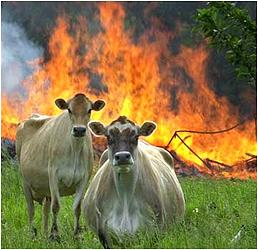We have a hockey friend near Guelph who is forever creating News-of-the-World type drama to keep his mates entertained. Like the girlfriend who held his cat hostage in a bar; missing hockey because he fell off a roof, and having his tractor spontaneously combust and burn his father’s Lincoln SUV also parked in the barn.
This summary from the Centers for Disease Control’s Morbidity and Mortality Weekly Report didn’t involve our hockey friend, but could have.
On June 6, 2011, a fire occurred in a barn housing approximately 240 week-old calves. A total of 34 firefighters responded from three Michigan fire stations and one Indiana fire station. Local  hydrant water and onsite swimming pond water were used to extinguish the fire.
hydrant water and onsite swimming pond water were used to extinguish the fire.
On June 20, 2011, the Indiana Department of Homeland Security notified the Indiana State Department of Health (ISDH) of an Indiana fire station that reported gastrointestinal illness among a substantial percentage of their workers, causing missed workdays and one hospitalization as a result of cryptosporidiosis.
All ill firefighters had responded to a barn fire in Michigan, 15 miles from the Michigan-Indiana border on June 6; responding firefighters from Michigan also had become ill. ISDH immediately contacted the Michigan Department of Community Health (MDCH) concerning this outbreak. The investigation was led by MDCH in partnership with ISDH and the Michigan local health department (LHD). Among 34 firefighters who responded to the fire, 33 were interviewed, and 20 (61%) reported gastrointestinal illness ≤12 days after the fire.
Cryptosporidium parvum was identified in human stool specimens, calf fecal samples, and a swimming pond. Based on these findings, the following public health recommendations were issued: 1) discontinue swimming in the pond, 2) practice thorough hygiene to reduce fecal contamination and fecal-oral exposures, and 3) decontaminate firefighting equipment properly. No additional primary or secondary cases associated with this exposure have been reported. The findings highlight a novel work-related disease exposure for firefighters and the need for public education regarding cryptosporidiosis prevention.
The complete report is available at:
http://www.cdc.gov/mmwr/preview/mmwrhtml/mm6109a2.htm?s_cid=mm6109a2_e.
